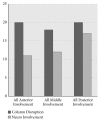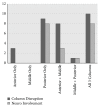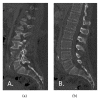Stability of the Subaxial Spine after Penetrating Trauma: Do Classification Systems Apply?
- PMID: 30402292
- PMCID: PMC6198542
- DOI: 10.1155/2018/6085962
Stability of the Subaxial Spine after Penetrating Trauma: Do Classification Systems Apply?
Abstract
Objective: Blunt spinal trauma classification systems are well established and provide reliable treatment algorithms. To date, stability of the spine after civilian gunshot wounds (CGSWS) is poorly understood. Herein, we investigate the validity of trauma classification systems including the Thoracolumbar Injury Classification and Severity Score (TLICS), Subaxial Cervical Spine Injury Classification and Severity Score (SLIC), and Denis' three-column model when applied to spinal penetrating trauma from gunshots, while secondarily evaluating stability of these injuries.
Methods: Gunshot injuries to the spine were identified from an institutional database from ICD-nine codes. Trauma scorings systems were applied using traditional criteria. Neurologic compromise and spinal stability were evaluated using follow-up clinic notes and radiographs.
Results: Thirty-one patients with CSGSW were evaluated. There was an equal distribution of injuries amongst the spinal levels and spinal columns. Twenty patients had neurological deficits at presentation. Eight patient had a TLICS score >4. Three patients had a SLIC score >4. One patient had surgical treatment. Nonoperative treatment did not lead to spinal instability or adverse outcomes in any cases. The posterior column had a high correlation with neurologic compromise, though not statistically significant (p=.118).
Conclusions: The TLICS, SLIC, and three-column classification systems cannot be applied to CSGSW to quantify injury severity, predict outcomes, or guide treatment decision-making. Despite significant neurologic injuries and disruption of multiple spinal columns, CSGSW do not appear to result in unstable injuries requiring operative intervention. Further research is needed to identify the rare spinal gunshot injury that would benefit from immediate surgical intervention.
Figures




Similar articles
-
Multicenter retrospective evaluation of the validity of the Thoracolumbar Injury Classification and Severity Score system in children.J Neurosurg Pediatr. 2016 Aug;18(2):164-70. doi: 10.3171/2016.1.PEDS15663. Epub 2016 Apr 8. J Neurosurg Pediatr. 2016. PMID: 27058457
-
Surgical Practice in Traumatic Spinal Fracture Treatment with Regard to the Subaxial Cervical Injury Classification and Severity and the Thoracolumbar Injury Classification and Severity Systems: A Review of 58 Patients at the University of Wisconsin.World Neurosurg. 2019 Jul;127:e101-e107. doi: 10.1016/j.wneu.2019.02.141. Epub 2019 Mar 6. World Neurosurg. 2019. PMID: 30851463 Review.
-
Predictors of Failure of Nonoperative Management Following Subaxial Spine Trauma and Creation of Modified Subaxial Injury Classification System.World Neurosurg. 2019 Feb;122:e1359-e1364. doi: 10.1016/j.wneu.2018.11.048. Epub 2018 Nov 15. World Neurosurg. 2019. PMID: 30448573
-
Parsing the Utility of CT and MRI in the Subaxial Cervical Spine Injury Classification (SLIC) System: Is CT SLIC Enough?AJR Am J Roentgenol. 2016 Jun;206(6):1292-7. doi: 10.2214/AJR.15.15492. Epub 2016 Apr 4. AJR Am J Roentgenol. 2016. PMID: 27043893
-
Thoracolumbar spine trauma classification: the Thoracolumbar Injury Classification and Severity Score system and case examples.J Neurosurg Spine. 2009 Mar;10(3):201-6. doi: 10.3171/2008.12.SPINE08388. J Neurosurg Spine. 2009. PMID: 19320578 Review.
Cited by
-
Spinal gunshot wounds: A systematic review of the literature.N Am Spine Soc J. 2025 Jun 21;23:100755. doi: 10.1016/j.xnsj.2025.100755. eCollection 2025 Sep. N Am Spine Soc J. 2025. PMID: 40756246 Free PMC article. Review.
References
-
- Farmer J. C., Vaccaro A. R., Balderston R. A., Albert T. J., Cotler J. The changing nature of admissions to a spinal cord injury center: Violence on the rise. Journal of Spinal Disorders & Techniques. 1998;11(5):400–403. - PubMed
LinkOut - more resources
Full Text Sources

